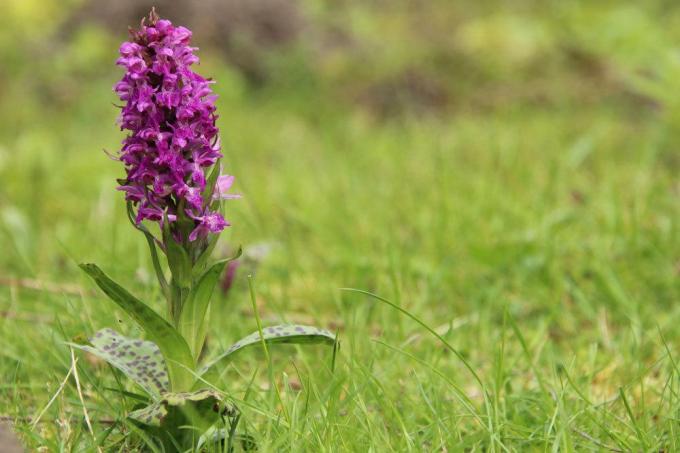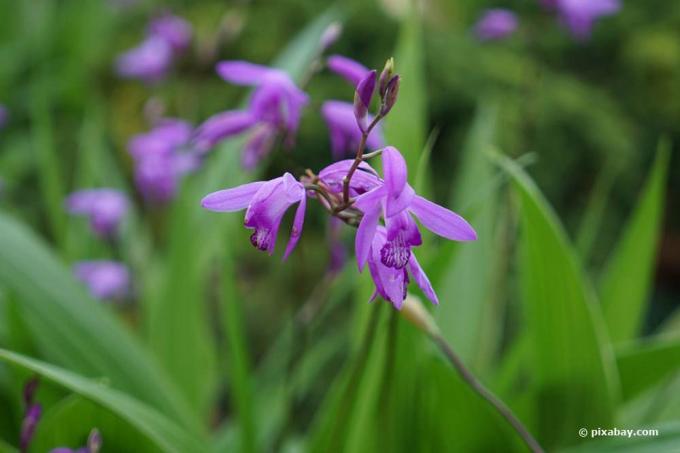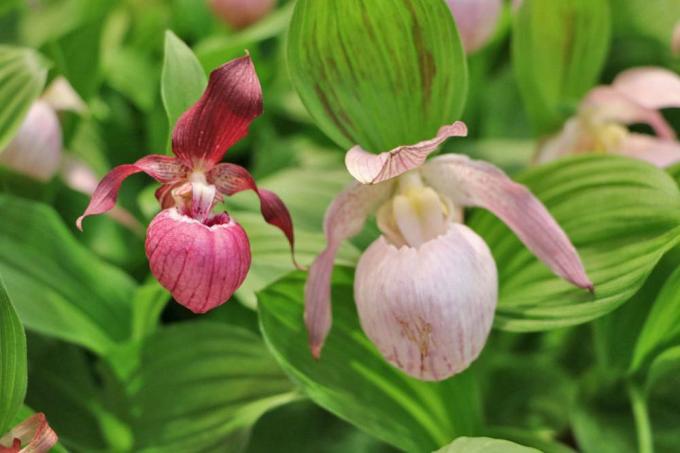
table of contents
- Hardy orchids
- Tibetan or mountain orchid (Pleione limprichtii)
- Japanese orchid (Bletilla striata)
- Lady's slipper (Cypripedium calceolus)
- Hardy lady's slipper orchid varieties
- Orchids (Dactylorhiza)
- Stendelwurz (Epipactis)
- Ragwurzen (Ophrys)
The beauty and elegance of an orchid, its extravagant flower shapes and colors cast a spell over every plant lover. These attractive plants are mainly known as houseplant. But you don't have to do without them in the garden either. Because a large number of orchids are hardy and can stand in the garden, on the balcony and terrace all year round, even in our latitudes, without being damaged.
Hardy orchids
Orchids kept as houseplant are usually not suitable for keeping outdoors. However, there are now numerous particularly robust and resilient species that have been specially bred for year-round keeping outdoors. In the trade mainly Tibetan and Japanese orchids and the lady's slipper are offered. But there are other, no less beautiful outdoor species such as B. Orchids, Stendel or Ragwurzen.
Tibetan or mountain orchid (Pleione limprichtii)
Not every species of the genus Pleione would survive the winter outdoors in our latitudes. The Tibetan orchid (Pleione limprichtii), however, has good winter hardiness and can stand in the garden all year round. It is perennial, grows upright, with heights between 10 and 15 cm. Its pink, funnel-shaped flowers with brick-red spotted, fringed lips appear from May to June. Under a closed blanket of snow, it can withstand temperatures as low as -20 ° C. If this is missing, however, it is advisable to cover it with a fleece.
Japanese orchid (Bletilla striata)
The Japanese orchid is one of the wild-growing orchids that are also suitable for outdoor cultivation in the garden. There they are up to approx. -17.7 ° C hardy. It is not uncommon for it to even get by without any protection. However, if you want to be absolutely sure, you can protect it with a cover made of dry leaves and fleece or bubble wrap. Bletilla striata opens its bell-shaped flowers in June / July for several weeks. The greatest enemy of this orchid is excess water in winter, but it should be avoided at all costs.
Bletilla striata 'alba'
- The easiest orchid to grow in the garden
- Forms beautiful stands within a few years
- Inflorescences arranged in racemes
- Bright white single flowers on red-green stems
- Flowering time is from June to July
- Height is approx. 40 cm
- For planting on the edge of the pond or suitable near water
Bletilla striata 'blue'
This rustic, approx. 30 cm high terrestrial orchid. The lip is predominantly white with a purple border and small spots. In the right location, it can withstand temperatures as low as -20 ° C.
Bletilla striata 'kuchibeni'
This up to 60 cm high Japanese orchid has white flowers with a slight lilac shimmer. The so-called lip has a pink or mauve edge. It blooms from July to August and is hardy down to -20 ° C.
tip: The soil should not dry out completely, especially in summer.
Bletilla striata 'pink'
The funnel-shaped flowers of this orchid variety are arranged like grapes and are light pink to lilac and white. But the basic color of the lip is also white with purple lines and a border. It is hardy to a maximum of -20 ° C and the height of growth is around 40 cm.
Lady's slipper (Cypripedium calceolus)
The terrestrial (on the ground) growing lady's slipper (Cypripedium calceolus) is one of the most magnificent and exclusive orchid species. It is very hardy and can therefore be cultivated outdoors. Depending on the variety, the flowers appear individually or in clusters. The leaf rosette consists of outwardly tapering leaves.
As a rule, each flower shoot only bears a single flower. But under optimal conditions there can be two. The flowers have four outer, widely protruding tepals that surround the actual "shoe". This can reach a length of four to eight centimeters. In the right location, these orchids are amazingly robust and can then even multiply over the years.
tip: In special nurseries, lady's slipper hybrids with different flower colors and tints are offered. This is to prevent protected lady's slipper orchids from being removed from their natural locations, which is forbidden anyway.
Hardy lady's slipper orchid varieties
Cypripedium Ventricosum 'Pastel'
Cypripedium Ventricosum 'Pastel' is a particularly exclusive variety with ivory-colored flowers. Depending on the plant and year, the flowers also have a smaller amount of red. In cool temperatures during bud formation, reddish stripes and spots may be seen. If it gets warmer in spring, however, these are missing. This hybrid grows to a height of 40-55 cm.
Cypripedium parviflorum - 'small-flowered lady's slipper'
- A rather delicate representative of its genus
- Reaches a maximum height of 30 cm
- Elegant flowers appear from May and last for several weeks
- Are very similar to those of the native lady's slipper (Cypripedium calceolus)
- Sepals (sepals) are chocolate brown and strongly twisted
- Labellum or the "shoe" is golden yellow and speckled red inside
tip: Due to its robust properties, the small-flowered lady's slipper is particularly suitable for orchid newbies.
Cypripedium kentuckiense
- This North American orchid species is hardy and suitable for outdoor use
- Has the largest flowers among the lady's slipper orchids
- The flower color is creamy-yellow to whitish
- Schuh is almost the size of a hen's egg
- Sepals (sepals) are also particularly large
- They are dark wine red and slightly twisted
- Flowers appear around the end of May
- Fully grown clumps of 60-80 cm, a real feast for the eyes
Cypripedium formosanum - Taiwanese woman's shoe
The Taiwan lady's slipper is a very classy looking variety. Both the flowers and the leaves are impressive here. The flowers are white, arched inward, and mottled burgundy. In contrast to the tapering other species, the leaves are fan-shaped and therefore particularly decorative. Cypripedium formosanum usually flowers from the end of April.
tip: Due to the relatively early flowering, it is advisable to protect this orchid from the winter sun in order to delay the shoot in the open a little.
Cypripedium x ventricosum
Cypripedium x ventricosum is a very robust variety with large, wine-red flowers. Both the sepals and the "shoe" are wine red with fine lines. The height is around 40 cm. The flowering period begins in May, with each shoot only bearing one or two flowers.
Orchids (Dactylorhiza)
The orchid (Dactylorhiza) native to Europe is also hardy and belongs to the orchids. Its long flower panicles, which consist of many individual flowers, convince with different pink, red and purple tones and drawings in the form of points or lines. The leaves are long, narrow and darkly spotted. The stature heights are between 40 and 60 cm. These plants feel good in fresh and moist locations, e.g. B. Most comfortable at the edge of the pond or in the bog bed.

tip: Unfortunately the orchid is also very popular with snails. Appropriate protective measures are therefore recommended.
Stendelwurz (Epipactis)
Stendelwurzen are one of the wild species. Its flowers only draw attention to themselves on closer inspection. They are typical, differently colored orchid flowers, in which the lower petal is again formed into a lip. They prefer partially shaded or shady locations with moist, humus-rich or poor soil.
Stendelwurz hybrid 'Sabine'
This hybrid has relatively large flowers for its species. Up to 15 splendidly colored and pleasantly scented individual flowers sit on a flower stem. This Stendelwurz flowers from June to July and is between 30 and 60 cm high.
Red-brown stendrums (Epipactis atrorubens)
The flower colors of this species can vary, but mostly they are brown-red or aubergine-colored. In warm weather they give off an intense vanilla-like scent. The stems are purple in color. Flowering time is from July to August and the stature height is 20-50 cm.
White or marsh stendelwort (Epipactis palustris)
- Sumpfstendelwurz, one of the most robust and hardy orchids in this country
- Outer bracts usually greenish and overflowing into reddish
- Inner, upper petals, like the posterior part of the lip
- White to light pink in color, with fine purple lines along the veins
- The front lip is white with a wavy edge
- Flowering time is in June / July
- Upright stems grow 20-50 cm, rarely up to 80 cm in height

Broad-leaved stendellum (Epipactis helleborine)
Particularly hardy and one of the most common native orchids is Epipactis helleborine. It is one of the few, not endangered species and can grow up to 80 cm high. From July to August there are delicate pink to greenish flowers on the stems, which are exclusively leafy below.
Ragwurzen (Ophrys)
Ragwurzen are also hardy orchids and a botanical specialty and masters of deception. On a stem can be colored and drawn differently blossoms sit. Not only are they brightly colored, they are also unusually shaped, because their shape and color are similar to insects. With stature heights between 10 and 50 cm, Ragwurzen are rather delicate. Another special feature are the two resting phases that these plants go through, once in winter and then again in summer.
Bee ragwort (Ophrys apifera)
The bee ragwort has large, exotic-looking, delicate purple flowers. There are between three and ten flowers on a stem. The lip of the flower resembles different wild bee species in terms of shape and color. Flowering time is from May to July. The growth height is 20-50 cm.
tip: This hardy orchid is one of the rarest and most endangered native plant species.
Fly Ragwort (Ophrys insectifera)
- Fly ragwort between 15 and 40 cm high
- Extravagant flowers appear from early May to July.
- Two to twelve flowers per stem
- Particularly noticeable is the black-brown lip, which is partly outlined in yellow
- Lip surrounded by light green sepals
- The flower looks like an insect
- One of the most distinctive indigenous hardy orchids
Bumblebee Ragwort (Ofhrys holoserica)
The bumblebee ragwort is also hardy and impresses with its colorful flowers, which appear in May and June. An inflorescence has two to ten flowers. The sepals are mostly pink, the shorter petals pink to red. The trapezoidal lip is dark brown with variable markings. Flowering time is from May to June. It can reach heights of 10-50 cm.




